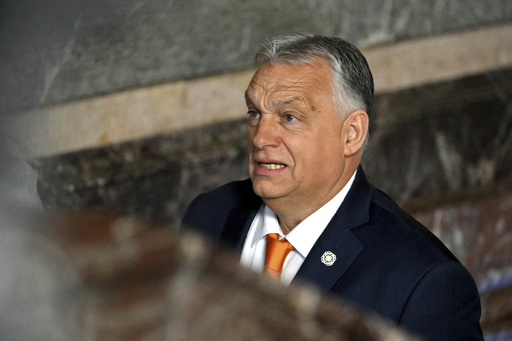
BUDAPEST, Hungary — Just hours before President Donald Trump took the oath of office for a second term, he echoed the sentiments of a Central European leader who spoke of a bright future. Prime Minister Viktor Orbán articulated that Trump’s return signifies not only Hungary’s own “golden age” but also the potential “collapse” of liberal democracy.
The parallels between their rhetoric were not unexpected. Orbán’s authoritarian style has attracted admiration from many U.S. conservatives, who view Hungary as a model for a conservative America characterized by reduced immigration, fewer regulations, and the dismantling of democratic limitations that they find burdensome. Orbán has cultivated a close relationship with Trump, having visited the president’s resort in Florida multiple times. This week, he commended Trump’s direct approach to engaging with Russian President Vladimir Putin regarding the conflict in Ukraine. During a presidential debate last year, Trump referred to Orbán as “a strong man” and a “tough person.”
Now that Trump has resumed office as of January 20, he is exploring the boundaries of executive authority in ways that draw comparisons to the anti-democratic tactics of Orbán and other autocratic leaders. Orbán has leveraged state power to suppress opposition, reshape the judicial system, and manipulate elections, making it challenging to unseat his Fidesz party. His administration has implemented severe measures against LGBTQ+ rights, immigration, the press, and civic organizations.
While the political landscapes of the two leaders differ, there are notable similarities between Orbán’s accomplishments in Hungary and the agenda that Trump has laid out for his second term.
The groundwork for Orbán’s political resurgence began after he faced an unexpected defeat in the election of 2002. Swearing that he would “never lose again,” Orbán and his allies devised a strategy to alter Hungary’s political framework, a plan that came to fruition after the Fidesz party won a decisive victory with a two-thirds majority in 2010. Kim Lane Scheppele, a professor from Princeton University who previously worked at Hungary’s Constitutional Court, indicated that while it wasn’t labeled as “Project 2025,” a conservative framework for Trump’s next term, it could easily have been termed “Project 2010.”
The European Parliament has deemed Hungary under Orbán as an “electoral autocracy.” Similarly, Trump’s return to power with a Republican majority has led to a flurry of executive orders aimed at enhancing presidential authority while challenging the nation’s system of checks and balances. He has moved forward with changes to the federal government without seeking input from Congress, prompting the American Bar Association to express concerns that many of his actions “contradict the rule of law.”
One of the most significant steps taken by Orbán’s administration was the assault on judicial independence. In 2012, the government reduced the mandatory retirement age for judges, resulting in the dismissal of nearly 300 senior judges, with their replacements selected by a political appointee closely associated with Fidesz. According to Scheppele, once Orbán had control over the highest court, he could operate with considerable impunity.
While Trump and the Republicans lack the ability to overhaul the judicial landscape unilaterally, they have pursued the goal of transforming the judiciary. Trump successfully nominated three of the nine U.S. Supreme Court justices during his first term, thereby granting conservatives a dominant position, which ultimately shielded him from legal repercussions related to attempts to contest his 2020 election loss. He has aimed to reshape the Department of Justice and has dismissed prosecutors involved in investigations of the January 6 insurrection at the Capitol. Moreover, his administration has criticized judges who have ruled against them, with some officials suggesting that unfavorable rulings could be ignored.
Despite these moves, Trump’s influence over the judiciary is not absolute, as evidenced by many of his appointees who acted independently to reject his challenges in 2020. The U.S. court system is also larger and includes judges appointed by prior administrations, including that of Joe Biden.
After regaining power, Orbán set about revising Hungary’s constitution and altering election laws to ensure his party maintained a larger legislative presence. These changes enabled Fidesz to achieve a two-thirds majority in every election since 2010, even when receiving as little as 44% of the popular vote. In Hungary, political parties, rather than the electorate, appoint candidates to parliamentary seats, allowing Orbán to wield substantial influence over government composition.
Zsuzsanna Szelényi, a former Fidesz founding member, indicated that Orbán’s control meant he dictates who can engage in politics, effectively leading the party as a singular entity. Orbán has crafted a narrative framing his party as the embodiment of true Hungarian identity, painting his opponents as unpatriotic. This tactic mirrors Trump’s own use of aggressive language against his political adversaries.
Orbán also systematically dismantled independent media in Hungary, allowing wealthy allies, who profited from generous state contracts, to acquire prominent news outlets. Trump’s administration has placed similar pressures on the U.S. media landscape through litigation and regulatory intimidation.
While Trump does not exert the same level of control over party elections as Orbán, he has steadily stamped his influence on the Republican Party, establishing loyalty to him as a core principle. This loyalty has influenced appointments to critical government roles, including leadership positions within the U.S. Department of Justice and other agencies.
Trump’s inclination toward authoritarian regimes resonates with Orbán’s trajectory toward autocracy, which has involved a closer alignment with Russia, China, and other similar governments. Géza Jeszenszky, Hungary’s first foreign minister post-socialism, noted that Orbán recognized the limitations of Western democratic norms and sought to draw lessons from those yielding more absolute control, particularly from Putin’s Russia.
While the fundamental political and economic frameworks in Hungary differ significantly from those in the United States, Szelényi warned that Hungary’s experience under Orbán should serve as a cautionary example. She expressed concern that once the process of autocratization begins, it tends to gain momentum, akin to a snowball effect. “It’s not something that stops — it’s a process,” she cautioned.

